WFB Bonneville 2009 Competition
By Bandit |

MITCHELL, S.D.— While their original “WFB” (World’s Fastest Bagger) sat on display in Mitchell, South Dakota, Team Klock Werks set out on their annual pilgrimage to the salt. This year was to be a lesson in education and humble attitudes. The team had decided this past winter to sponsor the World’s Fastest Bagger Traveling Cup Award. The idea was to award the trophy at the Bub Motorcycle Speed Trials Event held August 30-September 3, 2009, to invite others to compete and to share the true spirit and camaraderie that is racing on the salt.
Team Klock Werks entered into racing in 2006 with the WFB they had built for Discovery Channel’s Biker Build Off series, hoping that more builders and companies would join them, as they felt it would only lead to better performance products for baggers. True to this vision Klock Werks’ now number one selling part, the patented FLARE Windshield, was born on the salt from a need for downforce to aid in stability. Safety and stability were so important to president of the company, Brian Klock, because his wife, Laura, is the pilot of the WFB. Since their maiden voyage in 2006, Laura has continued to pilot the WFB, each year improving upon her record as the team continued to learn. The krew has heard talk each year of teams coming out to share in the challenge of going fast on a bagger, a style of bike that is meant for comfortable highway cruising and wasn’t really intended for racing, but few have come. So, this year they decided to sponsor the WFB Traveling Cup Award and invite them out!

The idea of the award was presented to S&S, they signed up and offered $500 in S&S product to the winner. ProCharger also joined the effort and offered $500 towards the purchase of a ProCharger system. As the award sponsor, Klock Werks threw in $500 in product and a gift certificate for a Flare Windshield. Some guidelines were put in place to keep the competition fair. It is a “traveling” Cup with the name, team and speed of the winner from each year listed and will be passed on year to year. The winner did not have to set a record – just had to turn in their official timing slip with the contestant’s top speed for a one-way pass. Obviously, the bike the contestant was riding had to be a bagger since it is a bagger award, and this year the award was only offered at the Bub event.

Four teams arrived to participate in the race for the cup, each was built around different configurations, motors, and classes, but all shared a common bond with the challenges a bagger brings. Chris Rivas of Chris Rivas V-Twin out of Fresno, California, brought his 1999 FLTR with a 135 cubic inch motor that was built and tuned at Chris Rivas V-Twin with S&S sponsored flywheels, cylinders, heads, cams, transmission, clutch and carburetor.

Kevin Edgmon of High Country Harley-Davidson in Frederick, Colorado, ran a 2005 FLTRI with a Jim’s 131 and a 5-speed. Thomas T.R. Reiser of T-Man Performance in Kernersville, North Carolina, brought his 2006 FLH running a 98-inch motor with a Pro-Charger setup, his T-Man Stage IV Thumper Series top end with T-Man 662-1 Cams. T-Man, Klock Werks felt, was to be commended for running a batwing style fairing! And a best wishes and call out to Rob Hassey of RacePro, Inc. who was the pilot of the Rowdy Rooster race team Road King running an S&S 124. The team planned to add a batwing fairing to the Road King to compete after their initial pass. Unfortunately, Hassey crashed on his first pass and was unable to continue racing the rest of the week. We hear he’s doing fine and the bike is rehabilitating as well! Hope to see them next year!
The winner of the exclusive WFB Traveling Cup 2009 was…..Chris Rivas with his fastest one way pass of 166.645 mph! Rivas will retain the WFB Cup for one year. The rest of the times turned in were very respectable as well! Kevin Edgmon completed a pass at 151.622 mph, and T.R. Reiser had a personal best of 158.103 on his Batwing Fairing 2006 FLH.

Team Klock Werks admitted that it was a challenge to leave the WFB home and sit back and watch, but they were on hand to pay tribute to the award winner.
Laura stated, “It really meant a lot to me personally, to meet each rider and share stories, experiences, and the challenges we have each faced racing these touring bikes. We wanted to share what racing on the salt has meant to our families, and to our businesses. It’s so fun! We are truly blessed to have to opportunity and to be able to share it.”
Brian Klock adds, “It was fun to see them run and hear the reactions of pro drag racers, motor builders and rookies. Chris Rivas commented about the time difference between a drag run and a salt run – that was an interesting perspective. A true testament to the diversity of the salt. It is a special place for us and so many others.”
Klock Werks thanks all the participants that came to the Salt Flats and the co-sponsors of the WFB Traveling Cup – S&S and ProCharger. Start planning for next year as Rivas will try to defend the WFB Cup! Klock Werks invites you to visit www.worldsfastestbagger.com To see the full spectrum of what Brian Klock and the team at Klock Werks is capable of, as well as S&S and Pro-Charger, please visit www.kustombaggers.com KustomBaggers
S&S Cycle
ProCharger 
Lower Alabama to the Badlands
By Bandit |

Well, we did it! We left LA July 24 and arrived at Katmandu campground in South Dakota on the 30th. We would have been there a day earlier but because of rain we decided to spend the night in Wall, SD and put up our tent while the sun was shining. We also did a tour of the Badlands on the way to the campground. A total of 1780+- miles to get there but it was worth it.

The Badlands are awesome. Having lived in forested, humid areas all my life being able to see such distances and it being dry and mostly treeless was incredible. What a great start to our tour of South Dakota.
We had decided on Katmandu campground because it was supposed to be family oriented and the quieter crowd usually hung out there. There were a few drawbacks. One was the mile or more ride from the paved road down a gravel road to the camp itself. Harleys with belt drive do not like gravel, a rock in a belt can play havoc with your ride. The flush toilets were few and down at the bathhouse, all the rest were your standard outhouse type facilities.

The showers for the women were adequate and well ventilated, from what my husband said the men's were not ventilated at all and it was like showering in a swamp. Food at the camp would keep you alive but it was nothing to write home about and expensive. We rode to Rapid City to eat most days at a truck stop off I-90 at exit 55 called Marlin's, great food but like every one else they had raised their prices due to the rally.

We did the road trips to Custer State Park (saw buffalo, burros, prairie dogs, antelope and more), Norbeck National Scenic Byway which includes Crazy Horse Mountain, Needles Highway, Sylvan Lake, and Iron Mountain Road, Mount Rushmore, Devils Tower (in Wyoming) the central hills, the northern hills and the southern hills. Our tours inside the parks and round about the area totaled around 1300 miles. We were usually the first ones up and out of camp, which did not make the party goers happy campers. On the second day we rode and came back to find our tent held down by two tables, our camping neighbors had stayed in that day and when the wind picked up they saved our tent and a few more, some they did not get to and they blew over.

We bought longer tent pegs the next day. We stayed seven days and at first the weather was great, cool mornings and warm to hot days but the humidity was low so riding was good. The fifth night we had a storm.
My husband had told me we were going to a place that had “weather,” he was not wrong. The wind blew so hard we thought the tent was going to blow away and it poured rain and lightening most of the night. Then day six was beautiful and we rode, but again that night we faced a storm, not as intense as the night before but enough to get your attention.
We decided to get out the next morning and it was good we did, news reports said the storms that came after that were even more intense with 3 to 4 inch hail and 60-70 MPH winds.
By then we were on the road again. We rode across I-90 headed East looking like we were both trying to make a right turn, we were leaned into the wind so hard. Found a great rest area near Chamberlain, SD. It has a museum of sorts to the Lewis and Clark Expedition, very interesting and a great view of the Missouri River. Met some folks from Alabama there also, small world. On the way home we decided to go see the Corn Palace in Mitchell, SD. It was a wonderful experience and very interesting side trip, amazing what they can make out of corn.

The rest of the trip home was good riding except for two days we spent in Columbia, MO due to rain. We made it home on the 13th of August, three weeks and over 5,027 miles later. Both bikes needed oil changes and a good cleaning, but what a ride.
Oh yeah, we made it to Sturgis for the rally one night. Got off the shuttle, walked down the street, took a few pictures, walked back to the shuttle and went to the camp. Too tired to go to the races.
Next time we are heading out before or after the rally. Prices are almost doubled during the rally as far away as 200 miles in any direction. I guess everybody thinks “bikers” are made of money. It was definitely an eye opening experience.

Well, we are back in LA and yes, the rain started, the first tropical storms of the season are headed our way and it is back to work Monday, as usual. Some things in life change..some stay the same. Until next time..
Ride Safe.
–Camy
September 11, 2001
By Bandit |
Effective immediately, the Motorcycle Riders Foundation office inWashington, DC will be closed until further notice. In light of thenational emergency that is taking place, and in keeping with thegovernment’s request to keep the phone lines clear, please do not try tocontact the office. Preparations for the upcoming Meeting of the Minds willcontinue, but the DC office will be closed for the time being.Beverly Waters and Tom Wyld are fine. They both made it into the officethis morning, but have since left and, for safety’s sake, will not returnfor an indefinite period of time.Please join us in keeping the family members and friends of the thousandsof victims of this senseless tragedy in your thoughts and prayers.Teri Hobbs, Assistant Director of Communications, MRF
THE FOLLOWING IS A NOTE FROM TOM WYLD REGARDING HIS OBSERVATIONS INWASHINGTON:
Capitol Hill has been evacuated, with Members and their staffs having leftfor home. Stores and restaurants on Pennsylvania Avenue are closed, and Iget the feeling we are on some enormous sound stage for a movie.
Sadly, with 10,000 dead in New York City, this is no movie.
At about 9 this morning, I walked over to Pennsylvania Avenue hoping tocatch a few staffers as I had heard some offices were closing. I heardwrong. Instead, I watched oceans of people pour from federal buildingshere, as the Mayor had declared a state of emergency and the Sergeant atArms had ordered the evacuation of the Congress of the United States. Bynoon, the streets around the Capitol Hill were all but deserted save forreporters and law enforcement officers.
Police cordoned off a one-block area around the House and Senate buildings,the Supreme Court and the Capitol Building. The barricade is one block fromthe MRF office, on East Capitol Street, N.E., and Second Street wheresome12 reporters spent most of the day. There, the reality begins to sinkin when you hear reporters drop the words “Pearl Harbor”
At this time (4 p.m.), there are still about 6 video cameras sitting in themiddle of East Capitol Street, all trained eerily on the dome of theCapitol Building. Still another camera and crew are atop the LutheranChurch of the Reformation, MRF’s neighbor a few doors down, similarlytrained on the dome.Customarily a friendly lot, the Capitol Policestationed at the entrances to the Supreme Court are stern-faced today, allarmed with fully-automatic rifles and short-barrelled pump-action shotguns.
As the networks covered a Pentagon aflame, the billowing smoke was visiblefor miles. One network camera positioned near the White House was trainedacross the river on the smoke from the Pentagon; in the foreground of thatshot was the Eisenhower Executive Office Building where MRF took ABATE ofIllinois to visit the President’s domestic policy staff.Times have changedso radically, so swiftly, it’s difficult to view that building in the sameway.
Perhaps the strangest part of the scene today, though, is sound —particularly the sound of fighter aircraft patrolling the skies above thenation’s capitol. Other than the occasional police chopper, you just don’thear aircraft of any kind in the skies over D.C., as the air space over theWhite House and Capitol Hill is restricted. About 10 a.m. I heard what Ithought was the sound of an explosion that seemed to emanate from the areadown toward the Rayburn House Office Building. Several others on the streetheard it, too; we soon dismissed it as a sonic boom, but it gets youlooking, listening. Anytime a plane was heard somewhere overhead, crews atSecond and East Capitol would hurriedly man their cameras, look through thelenses at the Capitol Building, and wait. Then a cameraman would say, “It’sone of ours,” and the crews would stand down.
Two AP reporters were walking down our street hoping to use someone’sland-line phone to call their office. (The cell phone system in D.C. hasgone crazy, I’m told; landlines are not much better.) I invited them to ouroffice; turns out I had worked for years with one of the reporters while atNRA. While walking around the block to grab lunch from the onlyestablishment on Pennsylvania Avenue that remained opened, she and Ihappened upon several Members of Congress, and she asked for theircomments. Florida’s Curt Weldon was on fire as he said that the first dutyof the Federal Government is the defense of the United States. “Politicianshave been bull-shitting the American people,” he said repeatedly (exactquote). Weldon was sharply critical of the intelligence establishment. Hehad just come from a security briefing by the U.S. Capitol Police,conducted at an undisclosed location. Weldon was outraged that the CapitolPolice received no intelligence heads-up whatsoever. Members of Congress(and the Capitol Police as well) learned that the United States was underattack by watching CNN. “Outrageous,” he said, “and it will not stand.”
The AP reporter also interviewed Senator and Mrs. Grassley of Iowa on 3rdStreet, a few doors down from MRF. The Senator used the phrase “act of war,but it was Mrs. Grassley who provided the reporter her favorite quote. I’llparaphrase: these people think that by killing other people along withthemselves, they will meet God. Today, they will realize they are wrong.
Even if we’ve seen the last of the attacks, things will change radically inWashington. Agendas are being rewritten and debated in the nearby homes ofstaffers and Members. Before Congress returns, every inch of House andSenate office buildings will be thoroughly searched for bombs. New securityprecautions will be instituted.Thus, it will be days before Capitol Hillresumes business as usual. And, judging from what we heard today, businessas usual in Washington is certain to be a thing of the past.
I have several letters going out, hopefully tomorrow, to various officialswithin the Administration urging new action on the issues of EPA, healthcare and traffic safety — issues where there is considerable distancebetween us and the Administration. I expect to close each letter with thesewords: “I hope we can work together to eradicate the distance between us onthese issues. Despite our distance, however, the bikers of America love ournation and support our President in this time of crisis, and we ask thatyou assure him of our prayers as he leads America through this dark hour.”
Tom Wyld
April 18, 2001
By Bandit |
Motorcyclists? Rights: LIVE at 2001 BEST of the WEST!
Motorcycle Riders Foundation?s Annual Western Regional Meeting Will Be Broadcast Live Via Internet MRF Washington, D.C. — Concerned about motorcyclists? rights and overall transportation safety on the American road? Better fly, drive — or, preferably, ride — to Phoenix, AZ, on April 6 thru 8 where the leaders of the American motorcyclists? rights movement plan their strategy for current legislative initiatives and beyond. This year, the Motorcycle Riders Foundation, the first voice for riders? rights in the nation?s capitol and the only Washington voice devoted exclusively to the street rider, will present the 2001 Best of the West at the Embassy Suites North at the southeast corner Greenway & I-17. Address as follows:
2577 W Greenway Road
Phoenix, Arizona, United States, 85023
ABATE & MMA of Arizona invites you to meet the MRF Board of Directors Friday evening. The General Session Saturday morning starts at 8:30 and will finish with MRFVice-President Tom Wyld?s presentation, ?Is Your Ride For Freedom Or Is MyRide Finished.? The afternoon offers sessions on Leadership, Computer Workshop,Strategic Planning For Your SMRO, Triage and Act/Create Successes for Your Organization, Budgeting For Your SMRO, SMRO Activities, and How Can You Be Most Effective In Your SMRO. The evening will wind up with a cash bar/social hour, banquet, and both silent and live auctions.
Can?t make it? —- Logon!!!.
MRF has selected INB Radio to transmit the conference live, on the Internet. A leader in Internet streaming technology, INB Radio will transmit the conference live – and make the conference available on archive for 60 days. (Click on inbRadio now for more details.)
This conference will be simulcast live on the Internet via the INB radio network. INBRadio can be accessed at www.inbradio.com, or as a direct link from the MRF web site, mrf.org.
Best of the West will offer a wide range of training and information. There will be state legislative reports, plenty of news on the globalization of the motorcycle industry and itsaffect on the American marketplace, an update on the proposed Environmental Protection Agency?s proposed rules covering motorcycles, and much more.
If you need the most up to date information on motorcyclist?s rights and safety issues itwill be delivered to your home computer on Saturday April 7 by the MRF and INB radio.It?s the next best thing to being there. The broadcast will also be on the INB archive listfor the next 60 days. If you can?t hear it live you can still get the information later, or goback and listen again to get all the details.
Former CHP Commissioner Maurice Hannigan Recommended to Head NHTSA
The Los Angeles Times reported yesterday that the National Safety Council isadvancing the name of a staunch anti-rider-rights advocate to head theNationalHighway Traffic Safety Administration. This development requires a vigorous response from the American motorcyclists?rights movement. California riders and motorcyclists generally have gone on alert atthe prospect of former Commissioner Maurice Hannigan being considered as thenext NHTSA Administrator. Pushed by the National Safety Council who hasopposed the freedom agenda of motorcyclists, former Commissioner Hanniganchampioned California?s mandatory helmet law. His opposition to motorcyclistsand their rights over the years has been staunch, vocal, and consistent. Hannigan is best known for formulating a helmet law enforcement policy that Federal Courtshave ruled violates motorcyclists Constitutional rights. The Federal Court for the SouthernDistrict of California issued the first ever permanent injunction against the CHP in their history.The injunction was upheld by the Ninth Circuit Court of Appeals. Call to action:
First: Call the White House at 202-456-1414. Politely but firmly explainyouropposition to former Commissioner Hannigan and any official for NHTSA?s topjobthat is not respectful of motorcyclists, our rights and our freedom. If youcan?t get through on the phone, send an email to the following: The President
Second: Reach at least 3 other riders NOW and urge them to make the samecall.
Third: Call your U.S. Senators at 202-224-3121 and explain your opposition toany official for NHTSA?s top job that is not respectful of our rights. Also,you can find your senators? email addresses atU.S. Senate
See Ya Al!

The country’s long ride toward installing a new President looksto have come to an end. Bikers have finally won one. George W. Bush has been a long time friendto motorcyclists, and promises to change the way we’re dealt with by the Feds. I had the pleasureof meeting and talking to him during the campaign, and he proved that everything my friend, Sputnik,said about him was true. The first thing he said to me was that he wasn’t going to let anybody turnback the clock on Texas riders, and that their freedom was his most important consideration when hesigned the bill to remove the helmet law for adult riders.
For all of you who heeded the call and turned out to vote, great job! Don’t let up, keep involvedwith the system. Make it your duty to check up on all of your elected representatives, andkeep in contact with them. It’ll be good for you, and good for them. Like voting, your rights need exercise, justlike with muscles, the more you flex them the stronger they get!
Rob Rasor Named AMA President
In a move that many around the country think was eleven months too latein coming the Board of Trustees of the American Motorcyclist Association (AMA)announced that Robert Rasor has been named the Association’s newpresident, effective Nov. 1.
The announcement was made at a meeting of the AMA Board at theAssociation’s headquarters in Pickerington, Ohio.
Rasor has been a member of the AMA staff for nearly 28 years, startingin January 1973 as a legislative analyst. In the early ’80s, he becamedirector of the AMA’s Government Relations Department, a postsubsequently titled vice president for government relations.
“FREE AT LAST,FREE AT LAST, THANK GOD FLORIDA IS FREE AT LAST,” exclaimeda jubilant James “Doc” Riechenbach III, President and Lobbyist for ABATEof Florida, moments after receiving a personal phone call from GovernorJeb Bush at 3:50 p.m. (EST) today, June 16, to tell him that he’d signedtheir helmet law repeal bill!
Doc, who also serves as Chairman of theBoard of Directors for the National Coalition of Motorcyclists (NCOM),said, “It’s been a long time coming, 31 years, and we’d just like to thankour ABATE members, NCOM and every state that helped us win our freedom!”
House Bill 1911 will repeal Florida’s helmetlaw for riders 21 and older who have a minimum of $10,000 in medical insurance,and will become effective July 1, 2000.
“The Bush brothers have now set two statesfree,” exclaimed Doc, referring to Jeb Bush’s brother and Presidentialhopeful, George W. Bush Jr., who as Texas Governor signed a similar billin 1997 to allow freedom of choice for responsible adult Texas motorcyclists.
Something tells me that Daytona Bike Weekis gonna be one Helluva helmetless celebration! NATIONAL COALITION OF MOTORCYCLISTS(NCOM)
NAVAJO NATIONREPEALS HELMET LAW
If you thought that states like Arizonaand New Mexico didn’t have a helmet law for adult riders, you were wrong…atleast until now. Although state laws in those Southwest states allow riders18 and older to ride without a helmet, a mandatory helmet requirement hasbeen in existence on all Navajo Nations land, even though it was seldomenforced by Tribal Police.
But the tribal council recently voted unanimously57-0, with no opposition, to repeal the helmet law on their Native Indianreservation lands, which is considered to be a separate and autonomousgovernment, and bring their law into compliance with other Southwesternstates comprising the Navajo Nation.
The helmet law repeal was signed by NavajoNation President Kelsay Begay on May 8, 2000.
NHTSA LIED–Whata Shock!!
Those of us who’ve been fighting in thetrenches for bikers’ rights have known all along that the National HighwayTraffic Safety Administration (NHTSA) has been fudging their statisticswhen lobbying against us on helmet laws. But now comes word from Ms. NHTSAherself, Saint Joan of Claybrook, who’s vision and leadership brought ussuch governmental boondoggles as the backwards-steering ”Safer-Cycle,”that NHTSA mislead the public regarding the safety of air bags.
According to a WASHINGTON TIMES editorial”Death By Safety Experts” forwarded to us by COWBOY over the Internet,former Carter-era NHTSA chieftain Joan Claybrook recently admitted thatNHTSA’s false or inaccurate claims over the years have ”hurt” the agency’sreputation and believability with the public, particularly with the ongoingfiasco over air bags.
Among other things, the editorial chargesthat while serving as NHTSA administrator Claybrook claimed that mandatingcar manufacturers to install air bags ”was necessary because of then-chronicunderuse of safety belts. She said that air bags could actually supplantseat belts and would provide superior protection.”
It goes on that ”Miss Claybrook, likeher mentor Ralph Nader, also claimed that air bags were the safest wayto arrest the forward movement of an unbuckled child in a frontal impact.In fact, an Associated Press photo surfaced recently depicting Mr. Naderdemonstrating an air bag simulator with an unbuckled young girl.”
We now know that it is precisely the unbuckledoccupants, especially infants and young children, who are most likely tobe killed or maimed by a deploying air bag.
”Mr. Nader and Miss Claybrook have yetto be called to account for their dangerously misleading advocacy,” saysthe Times.
Claybrook and Nader also put forth theutterly unsubstantiated claim that air bags would save up to 9,000 livesannually, states the article, although ”No factual evidence was ever givenin support of this gratuitous assertion. It is looked upon with derisionby knowledgeable industry analysts.”
Claybrook’s recent, belated apology forthe flood of dangerous falsehoods about air bags she turned loose some20 years ago is not much comfort to the more than 150 people, many of themchildren, who’ve been killed and the thousands who’ve been injured by thesegovernment-mandated ”safety” devices.
”True, air bags have certainly saved lives,”admits the article, ”But there is no question that they have also killed.No other safety device required by federal law has such a mixed recordof success.”
The Times editorial concludes; ”How manypeople will have to die before the government concedes it made a mistakeby ignoring the engineers and listening instead to know-nothing busybodiessuch as Madam Claybrook is anybody’s guess.”
More CaliforniaStuff
Politically active Cal Bikers broke a moritoriumin the Senate Transportation Committee, and pushed though a veterans licenseplate for motorcyclists.
Following months of frenzied lobbying byABATE of California and a biker veteran named ”Trash”, a motorcycle licenseplate to honor veterans has received an important nod from the Senate TransportationCommittee by a unanimous vote of 9-0. This vote reflects the strength ofthe motorcyclists’ lobby, as bikers faced an uphill battle in getting theirbill approved due to a self-imposed moratorium on approving any additionallicense plates in California.
Although AB1515 had received unanimoussupport in all the committee votes in the Assembly, including a unanimousfloor vote to send the bill to the Senate for consideration, it was stonewalledin the Senate Transportation Committee until motorcyclists and other specialinterest groups wanting specialized plates were successful in convincingcommittee chairwoman Senator Betty Karnette to lift the ban and allow avote.
In addition to creating a special plateto honor motorcycling veterans, AB1515 was further amended to allow motorcyclelicense plates to be issued for any existing car plate.
At this point, it looks like smooth sailingfor the Veterans Motorcycle License Plate bill, which has yet to have asingle vote cast against it. ABATE OF CALIFORNIA
5-Ball Racing, Bonneville 2010, Part 8
By Bandit |


This year seems to be kicking off slowly. Lee Clemens’ Departure Bike Work’s team is buried in snow, bad cameras, and struggling with a slow economy. We finally rolled the Bonne Belle onto Andrew’s lift. Andrew is the master fabricator at DBW. But there’s actually nothing plodding about this year. Days are scrambling past. Bonneville is just around the corner and check this:

All New Mojave Mile
That’s right – standing-start, flat out speed, as fast as you can go in ONE MILE! In conjunction with the Mojave Air and Space Port, a private airfield in Mojave, CA, we will host the first ever Mojave Mile Shootout event on March 6, 2010. This facility features a 12,000’ runway which will allow for very fast speeds (250+ mph) and a comfortable braking margin. Since Mile Shootout racing is already very popular in Texas, the Midwest, and the East Coast, we look forward to being the premiere site for Mile Shootouts in the West! While the premiere of the Mojave Mile is scheduled to be a one-day event, future events will be 2-3 days long and will attract up to 300 participants!
The Mojave Mile will be open to both cars and motorcycles, and, as the event grows in popularity, is forecasted to be held multiple times per year. Mark your calendar to attend one of the most exciting new racing venues in the country!
MKM Racing Promotions, LLC
9850 S Maryland Parkway, Suite A5-143
Las Vegas, NV 89183-7146
Phone 702-614-6108
Fax: 702-614-6109
www.mojavemile.com
Departure has been open for over 30 years and is a complete bike shop. You name it, they can handle it, from service, engine rebuilds (any H-D engine model or year), performance work, frame modifications, drag racing, sheet metal fabrication, sales, parts and parties.
I put the chassis together at the Bikernet Headquarters, including the sheet metal, and Lee was handling the engine rebuild. Everything has changed. We started with a stock 45 flathead, which we planned to run with two front heads for a dual carb 45. We shifted to installing a K-model top end for better breathing.
Then we started to chase parts, including performance cams. I gusseted the frame, powder coated it, and set up the sheet metal. I shipped the whole roller with Performance Machine wheels and rear brakes to Richmond, Virginia. Then I took a trip to Carson City, Nevada to visit the brothels and have a meeting with the boss of Paughco. Ron Paugh showed me his new 45 flathead frame designed to hold most big twin 4 or 5-speed transmissions.
Hell, I had cajoled Fatbob into donating a 4-speed Triumph transmission after we attempted installing a cut-away Sportster tranny in the stock frame. That won’t work.
Ron offered to build us a stretched single-loop Pauchco 45 frame for the Bonne Belle. What could be better? So the Hull Street Meanies from Departure Biker Works tore my roller down (the stock 45 frame and sheet metal is for sale to support our Bonneville effort).

Andrew and Stephen set up the rear axle, then the Performance machine brakes and rear wheel.



They installed the narrow glide front end after installing the Pauchco Timken bearing neck cups. Their plan was to install the stock gas tanks for a classic look and I’m about to ship them an Air Tech fiberglass partially streamlined fairing.


Actually, Lee has the stock 45, 3-speed transmission and a running, rebuilt 45 flathead engine, so my parts and piece are rapidly becoming a complete vintage bike kit for sale. It may also have a title. Check with Lee at Departure.

In the meantime Lee is still messing with the engine. Since we went with the K-model top end (the precursor to the Sportster) we could feasibly run a late model Sportster lower end for strength and performance. We could also run Sportster connecting rods and pistons. Plus, that allowed us to install Timken bearings on the output motor shaft. For a measly 45 cubic inch engine this was becoming severely complicated.

As it turned out the bottom end was too wide for the cases and the Timken bearings stick out of the left hand case. Lee machined a cap for the bearings but we’re still grappling with the bottom end.


Lee polished the connecting rods first, then shot-peened them for enhanced surface tension. The 45 left case was machined for Timken bearing set and races. When he discovered the problem with the bottom end, he machined the shoulder off the mainshaft for additional clearance.

He also had to machine down the pinion shaft race to allow for a Thrust surface on the right. Next we will bring you an update on the engine build and Andrew will be working on transmission mounting and alignment with the engine.

BDL has all the specs and they are building us a narrow belt drive and performance clutch for this application. I need to ship out the Air Tech fairing, then we need to hire a midget to ride it, or determine if Valerie will fit.

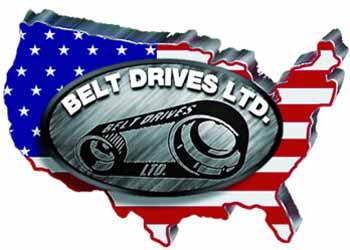



5-Ball Racing, Bonneville 2010, Part 7
By Bandit |

Bonne Belle Update
Another 5-Ball effort made progress. The 1940 WLD flathead, at Departure Bike Works in Richmond, Virginia witnessed true progress. Hidden in an Ozark Cave, until recently, were etched stones containing flathead speed secrets. Lee Clemens, the Boss of Departure, knows all who know anything about engines and performance. He had a distant drawn-and- quartered connection and came in contact with these highly secret tablets. The mystery continues

I’ll try to innumerate several of the 45 cubic-inch, side valve performance suggestions. Originally we discussed dual front cylinders for dual carbs and better air flow. There’s a problem with that recipe. First we found that K-Model top ends flow even better than dual carbs. Plus trying to find and possibly breaking up two sets of rare WLDR top ends wasn’t a friendly formula and a tough menu to follow.

That’s not all. Jim Lienweber would be forced to grind some very exotic cams for the dual-carb job, whereas a clean set of WLDR cams fit the golden formula for 45 speed.


There’s a baffle in one of the cylinders to create just the right mixture of oil to enter the cylinder under the piston of a stock 45. In the above case, part of our speed mixture, called for baffle removal to allow the piston to scream up and down the cylinder unhampered. Backing up that modification called for machining the breather gear in the cam case to create the ideal vacuum, let the motor breathe and the air evacuate. This also forced Ross pistons to deliver three piece oil rings over the stock one piece jobs.

In order to mount the K-Model top end, the precursor to the Sportster, a stud needed to be moved. Flatheads have four square studs, like at the corners of a square box. Sportsters and K-models come with one stud, slightly out of wack. It forced Lee to machine aluminum studs, run them into one cylinder mounting, case stud hole, slice it off and re-face the surface.
That’s not all. The cylinders needed to be measured from the crankpin up so that the head lands on the cylinders were perfectly square and the same between the cylinders for exact compression.

That’s not all. Lee needed to check the face of the heads and make them absolutely square with the top of the cylinders.

Lee discovered that there was a difference in the thickness of the heads from the valve side to the combustion side. He made a fixture to hold the heads perfectly square (upside down) so he could machine the correction into the mating surface between the aluminum heads and the iron cylinder head gasket surface. It took him a while to discover all headbolt surfaces are not created equal. He was forced to study the distances from the head gasket area to the headbolt washer landing to determine how to create the ideal fixture. He burned through another day in the shop trying to create the Worlds Fastest 45 Flathead.

That’s not all. Skeeter Todd dropped into Departure Bike Works to discuss all that’s performance in the kingdom of Harleys and the conversation shifted to the Bonne Belle. “What transmission are you going to use,” Skeeter said. Skeeter is like a monk from the flathead piston tribe in the Catskill Mountains. When he asks a question—he knows the answer.
“The stock 1940 three-speed with a tall rear sprocket,” Lee timidly muttered, knowing he was about to have his ass handed to him.
“With a stock 3-speed you will fall off the cam in third gear, and struggle through miles trying to retrieve the needed rpms to reached the peak power curve,” Skeeter pointed out graciously. The stock transmission was out. Lee has a connection for wrecked bikes through insurance companies and volunteered to cut a 5-speed transmission off a late-model Sportster and ship it to the other coast. “One problem,” he said. We need to seal up the case and develop a means to fill it with oil.”
Seems S&S makes a trap door with an oil fill hole and sealed bearings. Then it’s up to me to form the welded transmission case and mount it in the exact location from the engine drive sprocket as a Sportster, so we can run a Sportster designed belt system. We will also run the late model Sportster clutch, another beneficial project.

I immediately called Greg Friend, the former Street Chopper editor, who now the marketing director of Saddleman Seats. He cut a Sportster transmission free from the case to build a split Sportster custom. “Ah, I sold the transmission at a swap meet,” Greg said. “I’m using a Baker big twin transmission.”
I couldn’t believe my ears. See the image above. We shifted gears, found a transmission, cut it free from the Sportster engine cases, but it would not fit the 45 frame. We contacted Fat Bob and he recommended an old Triumph 4-speed. We started moving in that direction until Paughco announced they're new 45 frame designed to house a big twin 4-speed or Softail 5-speed transmission. That called for a team meeting. Hang on.


5-Ball Racing, Bonneville 2010, Part 6
By Bandit |
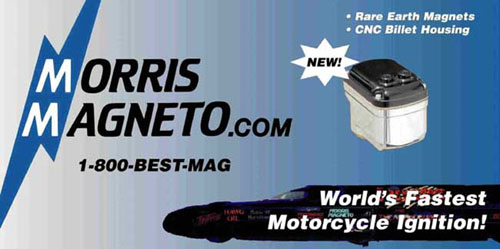

This is one of those features Bandit complains about then hands to me. He gets all the complete features and I get ones with shots and not text, or text and no shots. Or it get’s worse. I get the article about the yellow flamed bike and photos of a black scooter covered in skulls.
Dave Shaw is working with Bandit on a Morris Magneto for the 1940, 45-cubic inch flathead with a K-model top end for another pass at Bonneville. Departure Bike Works is still looking for pistons and we’re hoping Ross Pistons can help us. In the meantime Since that bastard Bandit installed Magnetos on may of his bikes we decided to do a feature on the Morris Magneto Line-up.
Magnetos are wonderful things for performance bikes and kickers only. They eliminate batteries and the right mag will last forever and even start when full of water according to Bandit. Talk about a simple chopper, hook up the regulator to the lights and run a kill button and that’s all. So here’s some of the Morris Magneto line-up. We’ll try to bring you updates on a regular basis. We have shots here of mags not featured on their own web site, so don’t hesitate to call ‘em and ask questions.

M-5 Fully Automatic Morris Magneto for 1970 and later Big Twin Harley-Davidsons.
Over a decade ago, we recognized the need for an ignition that would out-start any other ignition, kick or electric start, on any size motor from stock to totally radical. THE M-5 DOES JUST THAT! The secret is in the drive under the magneto. A spring winds up, then at the proper moment, the magneto whips through to provide a hot spark, no matter how slow the motor is turning.
Billet cam-cover and mag available in 'as machined' or polished finish.

Impulse G-5 For generator-style Big Twins
Same features as our M5, and more… no interference problems with cylinders, frame, and relay boss. Fits '36 to '69 and aftermarket Gen/Alt cases. The startin'est thing around!
This mag is a test to tune, but once on the mark it automatically retard the spark for easy starting and kicks it back to advanced position once it’s rolling. It also pre-winds the mag for the largest, most powerful sparkplug charge. The instructions call for light, easy kicks, no leg-breakers necessary.
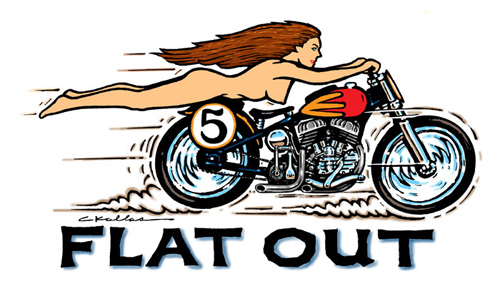

MM3 For '57-'70 XL; K, 45 & 80 Flatheads
Firm mounting- no more base leaks. Use with or without a battery. Auto advance. Manual retard for easier starting.Easily installed 2-piece design. No extra mounting hardware to buy. Also available in kit form MM3K for converting stock mags (note: no provision for base-driven mech. tach).

NEW! MSF (PAT. PEND.)Our Latest Creation
In-line solid state adapters to convert your magneto to single-fire, for single or DUAL-PLUG applications! Now you can run dual plugs from a single mag! (Dual plug operation requires the use of 2 MSF units.) Only the live cylinder fires.

“The picture of the yellow wires (I think there's 2 or 3) are the singlefire units (p/n MSF),” said Dave. “The generator mag works similar to the G5 and M5,but also a special gear has to go into the cam cover.” We may bring you a tech on installing the single fire unit in the near future.

“The mag pics with the stem are theFlathead ones,” Dave said. That’s the unit we need for our 5-Ball Racing 45.

“There's a picture of the rare-earth rotors we put in our mags,” Dave added.


The rest of the mag pics are our H5 generator-hole-mounted mag, availablemid-January ('07, I hope!),” Dave said.


MORRIS MAGNETOS, INC.
103 Washington St.
Morristown, NJ 07960
Telephone 973-540-9171
Fax 973-605-8910
http://www.morrismagneto.com/

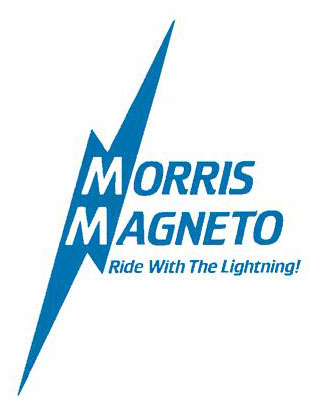

5-Ball Racing, Bonneville 2010, Part 5
By Bandit |


I’m running back and forth between bikes fabricating shit, waiting for parts, dodging bullets and counting the days. Yesterday I received a note from David Zelma at Performance Machine. “We found the front caliper bracket,” he said and I sighed. I was beginning to wonder whether I dove into an odyssey to find the un-findable part.
I can visualize that 10-inch front brake rotor bracket. I could swear I owned one at one time. Here’s the number, PN 1208-0017. It was designed for their standard 4- piston calipers to mount on XL-FX 1978 through 1983 with 10-inch disc brake rotors. The 10-inch number is the critical bastard. I have a handful of the ’84 and up jobs for larger rotors. If you have one of the 10-inch brackets, frame it and mount it on a wall.

So we shifted to the rear bracket. We had the coolest PM 8-inch floating rotor without holes in the aluminum center. Jay took it home and carefully measured the center of the lip, figured out five even positions and drilled them.

The PM based rear wheel hub needed to be drilled, for the rotor and that was going to be a trick. We didn’t have a drill press base large enough to reach the hub but we did have a large chunk of 6-inch steel tubing and center punches to mark the holes.

We marked, punched and drilled the holes with guide holes first. We taped the drill bit to give us the proper depth without drilling through the hub. Then we drilled the holes the proper diameter to tap them with 5/16 coarse threads.

With the rotor drilled and fitted, we dug around for a bunch of domed Allens to fasten the rotor to the hub.
The bolt heads needed to be shallow enough to miss the caliper bracket and stainless domed heads did the job. The other consideration is strength. According to Derek from DMP Enterprises, our fastener connection, (818) 775-9804, we should not use stainless fasteners on rotors. “You need grade 8 fasteners,” Derek said.

Okay, but this is a much lighter, less powerful bike. Next move, a wheel spacer between the two Timken bearings in the hub and Jay brought over the seamless tubing necessary, and we did our damnest to make a measurement. Then he took the data to the lathe and cut the tubing square to make sure the bearings ran true to the races in the hub.

After several precision cuts, Jay cut the bearing slightly short and we used a couple of shims to make it good with a clearance of .010-inch. Then I greased the bearings thoroughly and slathered grease on the races. With the spacer/shims in place we installed the bearings and seals. The wheel was ready to rock. We needed to grapple with the small rear PM two-piston caliper and mounting bracket.

This is a tricky Performance machine setup. It works with several sized rotors for axle spacing. It also allowed us to run the anchor bracket out either side of the caliper. It bolts into the middle of the caliper halves. First, we determined where to drill the ¾-inch axle hole by the PM gauge stamped into the caliper bracket. We drilled a guide hole then the major ¾-inch puppy.

Here’s the deal. The bracket fit right onto the axle, then we had to take the caliper apart and install the anchor-rod bracket. As you can see, in the top of the shot below, the bracket is sticking north. It can also be installed aiming south, or east and west, depending on how you’re holding the caliper. I musta split that caliper a half-dozen times during this process.


It was a trip figuring out all these components and how they fit together. You get the results of all our puzzle work. Okay, so once we put all the pieces together properly and wrapped the caliper over the rotor, centering the pads with the proper wheel spacer, we installed the wheel.



Our first custom notion was to mount the caliper Softail style so the caliper rested between the frame rails. We actually manufactured a brake anchor bracket and machined it to fit perfectly. Then we discovered that the wheel was seriously off center and we’d misplaced the sprocket spacing. We had to regroup.

We returned to the bike and dropped the axle caliper bracket straight down to allow the bracket to act as one of the wheel spacers and be pressed against the frame axle plate. There was a catch, a lump in the frame that didn’t allow the plate to set flat.

Bikernet.com does not have a CNC machine, but a BJ&M (Bandit, Jay and Masa) machine. This is truly state-of- the-art machining. Jay controlled one cutting direction, I controlled the other and Masa sprayed the cutting fluid for perfect accuracy and efficiency.

Note the cutting fluid being precision fed into the Bikernet Machine Shop operation.

We notched the bracket then discovered that our notch was on the wrong side. No worries, as the Aussie’s say, we flipped it and notched again.

During this operation a highly trained guard cat watched the shop door while positioned in the fairing we planned to modify for the 45 flathead, Sportster front end, since we my run this puppy in the partially streamlined class.

We’re missing some shots of the heim joint anchor rod we built and fastened to the frame through an Epson scanner glitch, but we’re working on it. We may retrieve them yet. In the meantime our frame is out to powder at Foremost in Gardenia.
But the shop isn’t on vacation. We’re cleaning the shop, rearranging equipment and refurbishing some new-to-us equipment in preparations to build these two bikes fast, once the powder is back.

We captured two old Delta wood working machines and transformed them into metal shop hands. One is a belt sander and the other a band saw. We needed both. We cleaned and grease ‘em, then try to make ‘em work. My problem was finding the right blades for the band saw in the correct length.
John Reed, the V-Bike designer for Custom Chrome, came to my aid.
You can get a blade welder. You buy a bulk length of blade cut it to length, put it in the welder and it joins each end. Then you have to heat the weld red, and let it cool, to anneal it. Rutland tools sell lengths of Starett band saw blades in specific lengths.

Come to a crunch, you can get your saw blade the right length, grind each end so it chamfers to a razor edge about ¼-inch in on each end of the blade.Put some silver solder flux and warm it with a gentle negative acetyline/oxy flame until it melts, (just under red) and touch it with just enough silver solder to let itcapillary across the surface, hold each end together with some flux, heat it, and it will join, and grind the side so its the same thickness all over.

We tried the welder and it didn’t work so we decided the man with the torch could weld it, and I did, very carefully. Then ground it and we have a working bandsaw, I hope.
Next, I’ll bring you the exhaust pipe fab on the V-Bike 120-inch Panhead, followed by the assembly process on both bikes. We’re burnin’ daylight and Whiplash reminds me of the Sturgis deadline on a weekly basis.

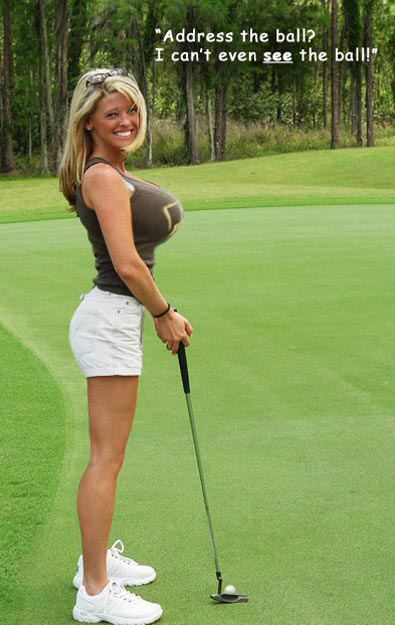
5-Ball Racing, Bonneville 2010, Part 4
By Bandit |

This is nuts. But let me try to explain. We’re making progress fast. Even our Bonne Belle art improved from a Chris Kallas black-and-white line drawing to a colored rendition by the master. Rick Krost straightened and strengthened the frame last chapter and we ordered Paughco cups designed for this frame (with Timken bearings) with a 7/8-inch, Paughco Springer stem. We (Settle’s Cycle, in Harbor City) machined the stem and pressed it into the Sportster bottom tree.

Larry Settle also laced the PM hubs to the aluminum Sun Rims, mounted the V-rated Avon Tyres and balance the lot. We were rolling. Our goal was to turn this puppy into a roller, ship the sheet metal to Jim’s Custom Paint, while the frame and brackets were being powder coated. I’m getting ahead of myself.
We were jazzed to pick up the wheels. We machined the rear hub, estimating the distance to the sprocket face from the frame, aligning it with the transmission sprocket. Fortunately we had access to a 1939 WLDR and made measurements. We ended up machining both sides of the rear PM hub before the wheel was laced.

With complete wheels in our hot welding gloves, we returned to the Bikernet Headquarters and went to work. First we had to shave 1/32-inch off the rear axle landing to slip in the new Custom Chrome ¾-inch big guy axle. We looked at grinders, and various tools and decided to hit it with the traditional metal file and some cutting fluid. It took no time at all for the axle to slip in securely.

Next we installed the front wheel on the stock Sportster front end with the springer stem. The bike set way too high. The stock ’39 stood between 4.5 and 5.250 inches off the ground with an original springer is place. Rodan, an avid Bonneville racer and SCTA official, told me recently, “You want your bike to set as low as possible and eliminate anything off the front that will interfere with air passage.” We need to keep lowering this sucker. It’s currently close to 6 inches in the air with the tubes pushed up through the top Sportster triple tree.

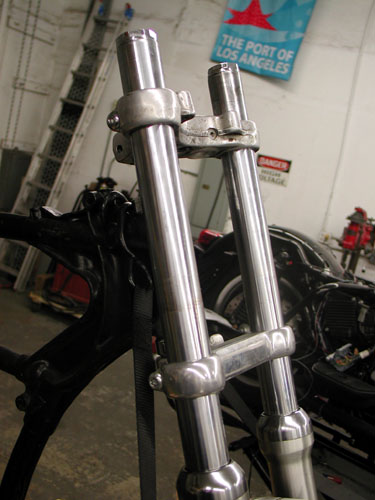

Next we needed to mount the rear fender so it would be ready for Jim Murillo, the master painter, to go to work. He already has the tanks and a stock Sportster front fender. We looked for a narrow front fender for the small Avon, 120/18, rear tire and discovered a heavy gauge Kraft Tech front fender and started pondering do-ability. We laid it over the tire and found some old rubber (used to vibration dampen handlebars). We cut it in two and duck taped it to the tire. For racing clearance we gave it about ¾-inch of clearance from the tire surface on the top. It was sorta tight on the sides.
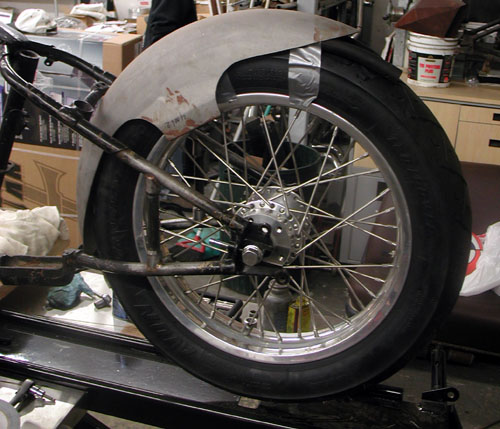
We decided to use the front fender tabs instead of shaving them and running standard fender struts. We dug around the shop for some stock that might match the material used to gusset the rear fender arms. We wanted to give it the same caped look as the gusset tubes with an outside sleeve at the ends.
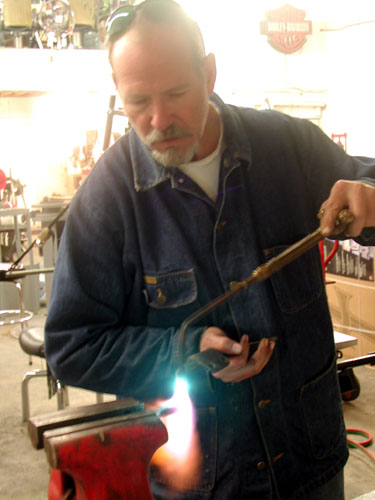


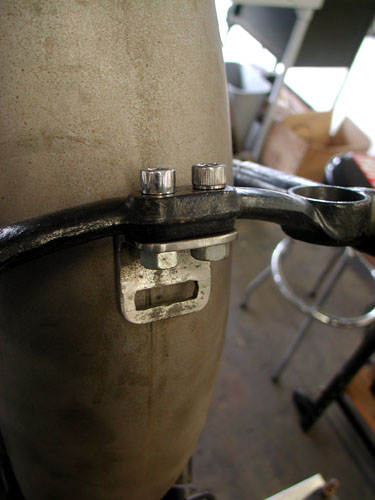
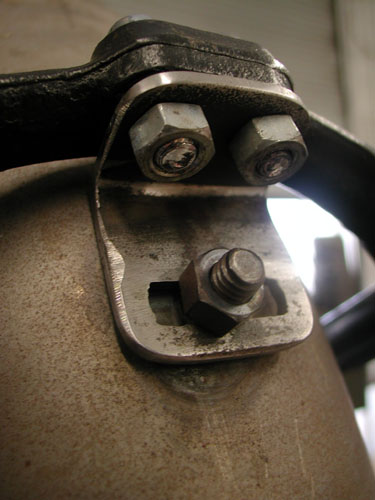
With the fender rails in place and fasteners tightened we discovered that we still needed something in front, although we were elated with the outcome. They were solid as hell. We cut a chunk of angle iron and drilled it to fit the frame. Then by drilling and using a Dremel tool cut-off blade, we cut a slot in the bracket to allow the fender to be shifted right or left. Finally we welded a bolt to the inside of the fender for ease of installation and adjustment.
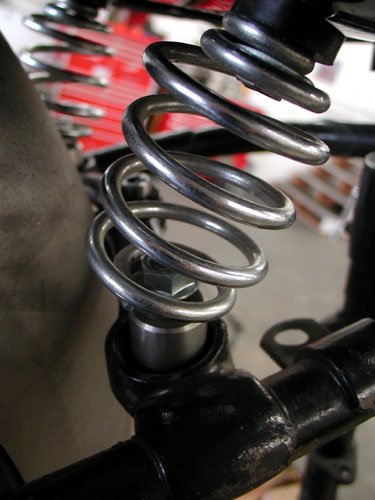
The last element we could mess with, at this stage was the seat. I’m constantly shifting seats around the shop. This seat was destined for the Salt Shaker for awhile, but it fit the 45 like a glove, so I looked for spacers so it would sit enough above the fender and the springs wouldn’t rest against the frame and fuck with the finish. I save anything that might be considered a spacer. We dug through the drawers and discovered two perfect units, made of stainless steel, a bonus.
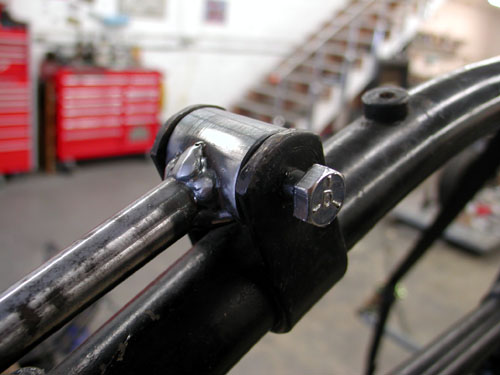
Back to the milling machine and shop lathe we cut a spacer for the front of the seat and machined it for a perfect fit. We furrowed another chunk of tubing and welded it to 6-inches of steel strap. It was drilled for the bottom of the seat then welded to the tubing.
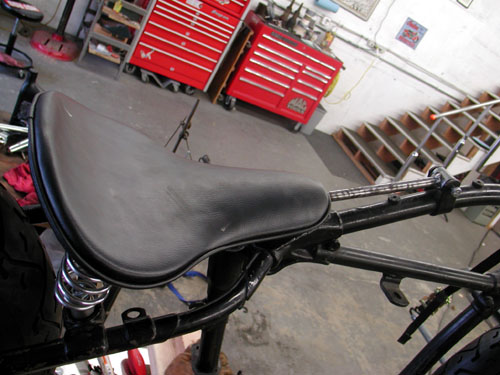
The seat fit perfectly with the bike. We are trying to position Valerie so she can tuck in and low for the blast along the salt. Wait till you see the handlebars in place.
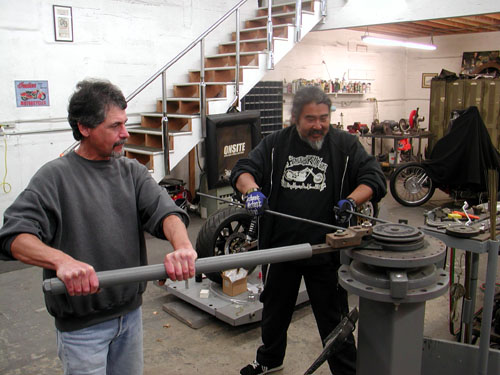
We were just about to slam the door shut on the shop for the night when Japanese Jay showed up and asked for help building his sissy bar. It was another chance to get some experience with our Bill Hall strap-bending machine. Chris Kallas our official Bonneville Team artist was helping us with the 45 and gave Jay a hand bending the solid stock.
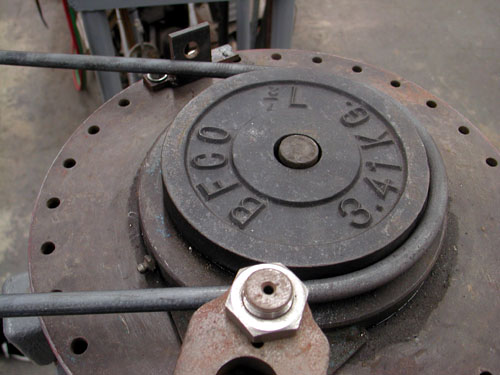
We looked around the shop for the perfect diameter guide and discovered various weight plates, from the Bikernet Gym, might do the trick. We tried 2.5 pound, 5 pound and ultimately 7.5 pound, which worked like a goddamn dream.
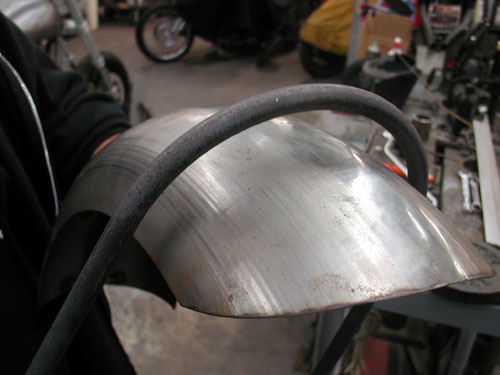
This move could be introduced in any shop with a weight plate and a strong vice. It would be tougher to handle than with this bastard, but you could pull it off. The rail fit Jay’s fender like a dream.
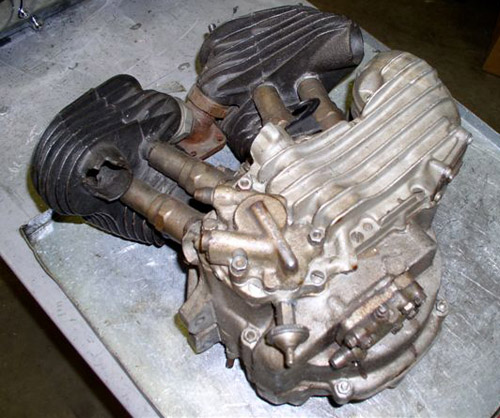
Wait, there’s more. The brothers, at Departure Bike Works, have stripped the Bonne Belle engine and are preparing for hop-up rebuild. The initial plan called for running two front cylinders, dual carbs and bigger valves and pistons. I snagged Greg from the Service Department:

Klink Walton (resident guru of flatheads & other things ancient), and Billy Wheatley (resident motor wizard & stripper afictionado) were the two brave souls who tore into this old, decrepit hunk of iron. Overall, things went pretty smoothly, although Klink forgot to bring all of his special 45″ tools (some guru, huh?)
A few things we noticed were, one of the cylinders had a broken exhaust flange. No biggie, Klink wants to use a set of WLDR cylinders (if we can find a set, hint,hint Bikernet readers). We also noticed the motor had a military oil pump set, by the olive drab color they were sporting. Nothing major, just an interesting little tidbit.
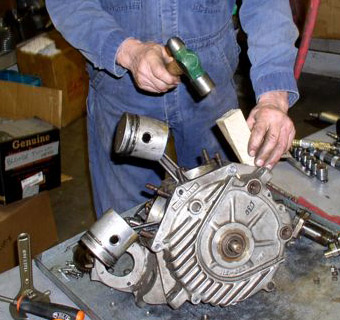
We noticed that the cases will need a bit of welding and machining, but WTF did ya expect on a motor of this vintage. It was about this point that Klink realized the need for a special case splitting tool, so off he went to the bandsaw, and returned with the tool you see pictured. I'm sure it'll be available in the JIMS catalog shortly…
Anyway, the cases were split, the flywheels removed & disassembled, blah, blah ,blah, and we were left with a large pile of parts that smelled like the funk of forty thousand years. Our next step will be to separate the good from the bad & the ugly, and order all the trick parts we're planning to use in this beast(if you can call a 45″ flatty a beast), so STAY TUNED!!!!!
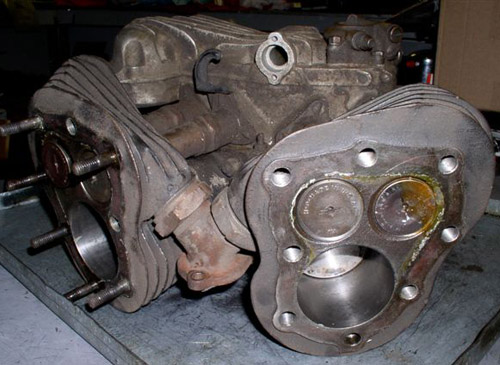
These are WLD cylinders and WLDR already have larger valves and better ports with less distance to the cylinder. The Departure Bike Works boss asked if I could find two front WLDR cylinders, which seems an impossible task. I don’t feel right about breaking up a set either, so I think we’re going to weld up and machine the ports and machine the heads for larger valves. We still need to find another front aluminum head.
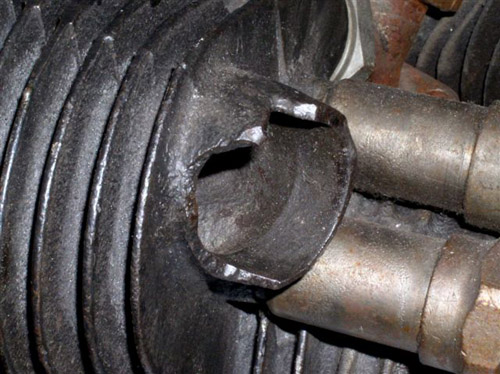
The next challenge is having new cams ground. Again, I spoke to Rodan who told me that KR cams will work, or Andrews Bonneville Sportster cams for higher lift. We need to separate the lobes from the gears, switch gears for the reversed valves and put the sets back together. We’ll see. More reports coming soon.
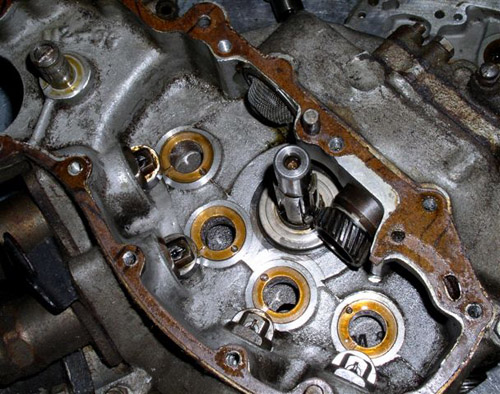
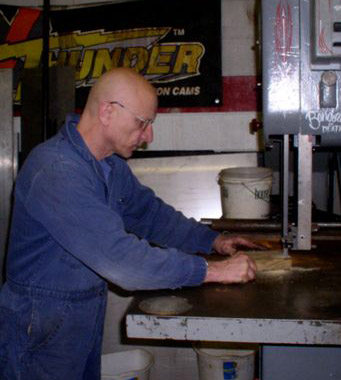
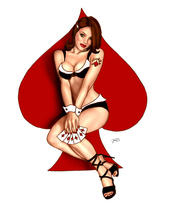
5-Ball Racing, Bonneville 2010, Part 3
By Bandit |

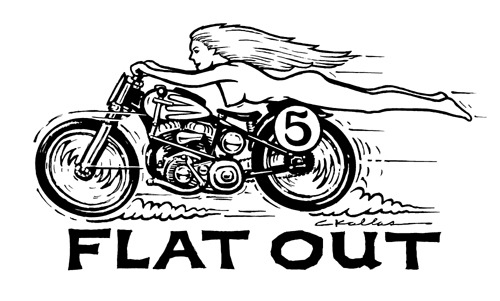
In the last segment the crew of U.S. Choppers straightened the Bonne Belle, 1940 45 frame, but I asked Rick Krost, da boss, if he felt any gusseting was necessary. He pointed out all the strong factory gusseting in the front and even on the single down tube, but suggested that we gusset the rear legs to strengthen the point as which the power hits the salt. My concern was in many respect for Valerie Thompson, our Bonneville Salt Flat rider.
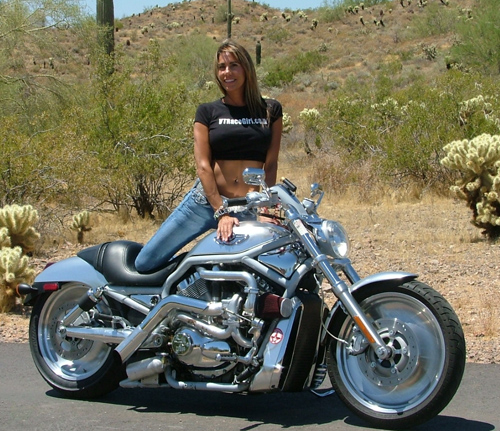
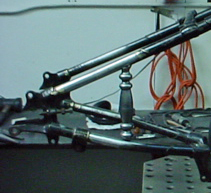
I could tell, while working with Rick, and witnessing his watery blood shot eyes that he was either coming down with something or hungover. His first rocking chair gusset notion met with mixed reviews.
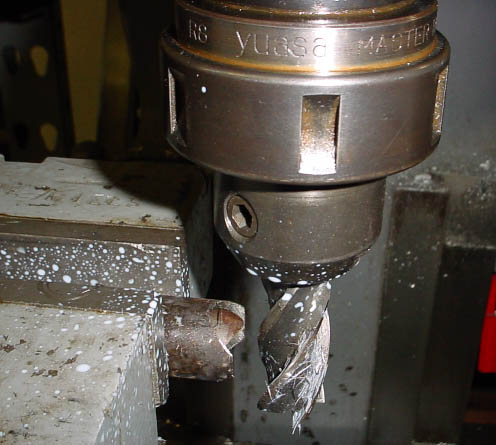
First, I coped the pipe after fitting it all to make sure it would all line up right and fit snuggly to the rear frame rails,” said Rick Krost. “I compounded the top “fish lips” by running the mill head at an angle… 25 degrees to be exact.”
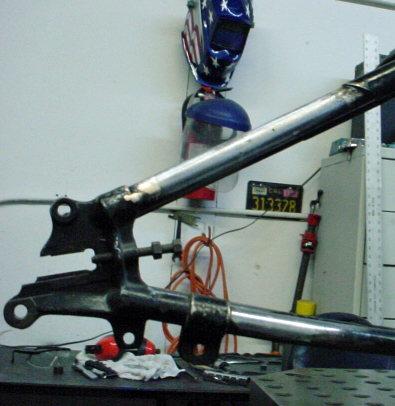
It's real important to have the weld area clean before welding… nothing like emery cloth and elbow grease.
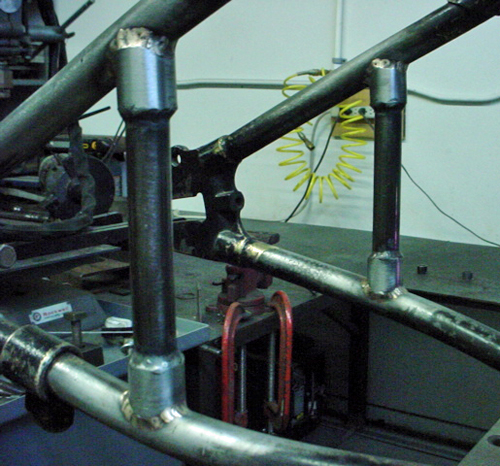
To make matters fun, these old frames are all furnace brazed. There’s brass everywhere on these frames. A lot of the times the pits in the metal keep you from cleaning all the brass out of the clean metal, which is bad for welding mild steels with 70S2 rod. It will contaminate your welds and they will fail.
“I chose to weld the pipe to the stanchions with steel,” Rick said. “and then weld it to the frame with Silicon bronze to avoid any contamination issues or weld failure.” Another benefit of SIB is that we can work around the tubing quicker as it has a lower melting point so as not to put too much heat into this old brazed frame..
”I used a clay heat sink in front of the castings or a sloppy wet rag,” Rick said, “depending, so the heat doesn't crawl over to that nice furnace brazing and loosen it!!! This could be bad!!!”
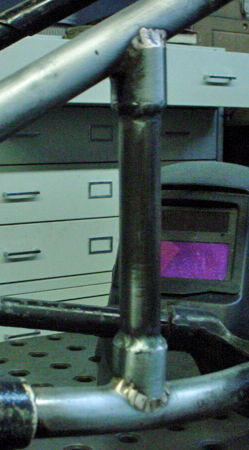
Done deal– the supports lined up well and were symmetrical. The 3/4 tube was used to help with any possible chain rubbing issues and they tuck up nicely between the frame rails.
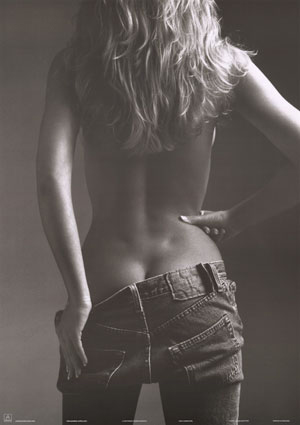
Look at those rear frame rails. Notice how they line up and are parallel to each other? That was the frame fairy's work the other night…. boy is she good. “This frame was about 3/8-inch out of alignment, when we started this project,” Rick said. “U.S. Choppers putting old steel back into use again!”
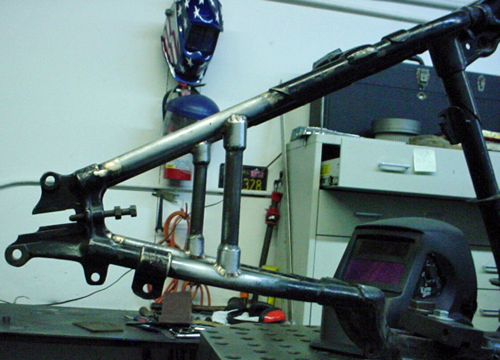
“Hey Bandit, come down with this flu…,” Rick sniveled, “I'm outta here… go cuddle up to my wife and her girlfriends. It's 8:00pm and I'm hoping your liking the finished result.”

He only uses Proto-Fab tubing. It is seemless, cold rolled and drawn over a mandrel bender. No seems or scale that must be removed. “All size increments will slip-fit over the next size,” Rick said, “so no machining was required.” He welded each piece with silicon bronze rod using a Lincoln TIG 355 battleship welder.

